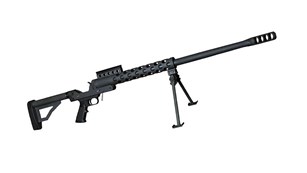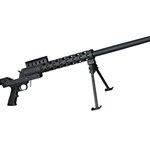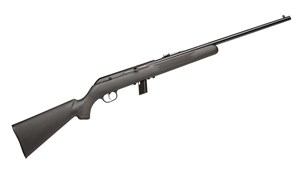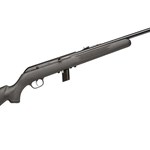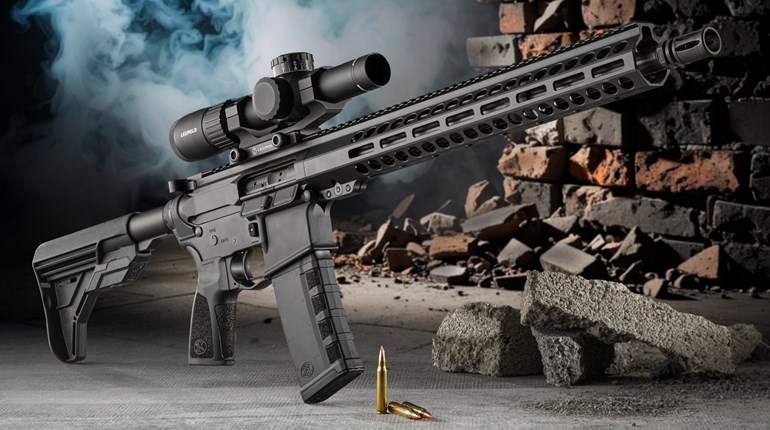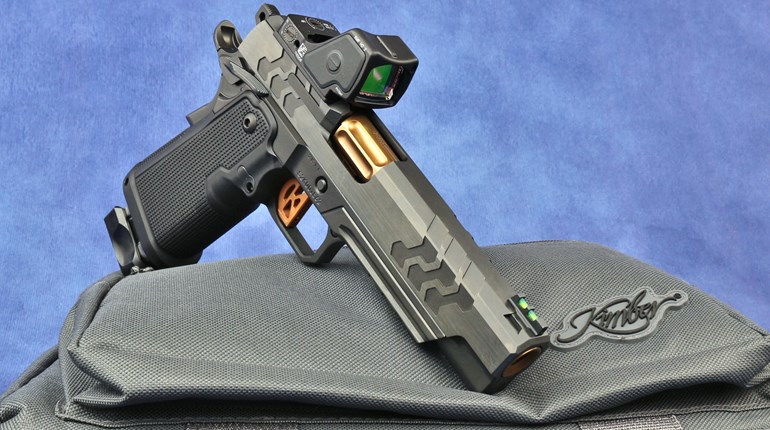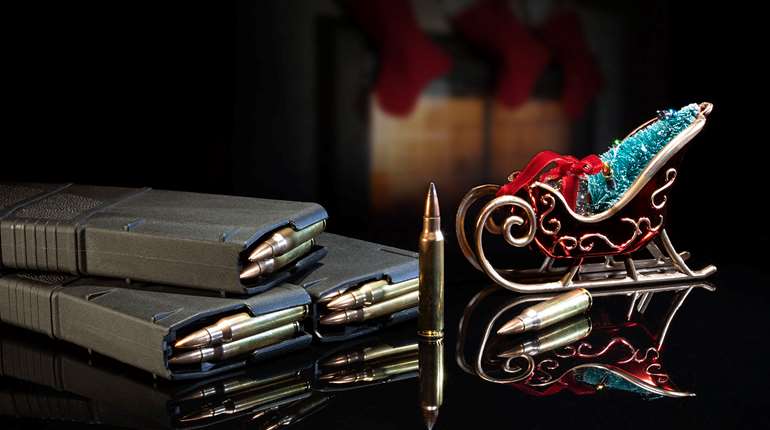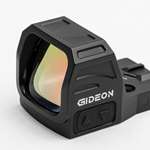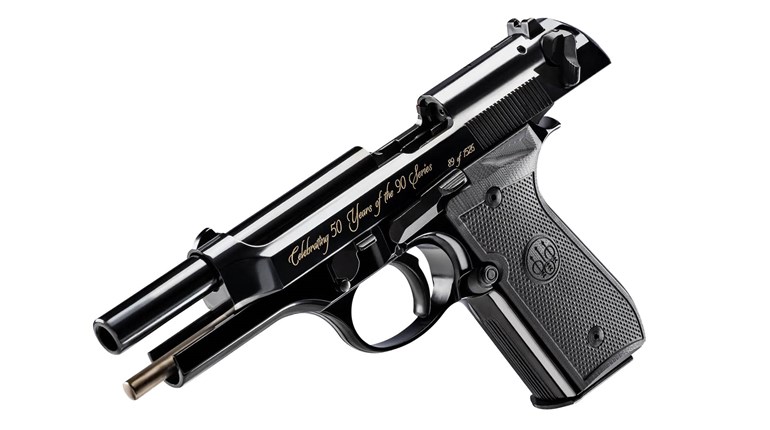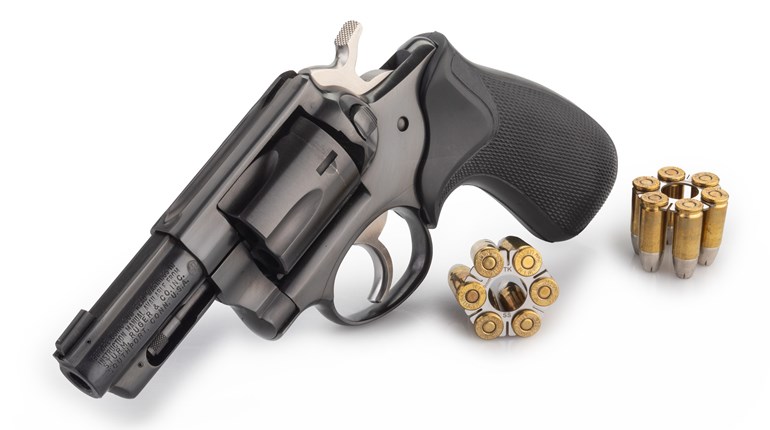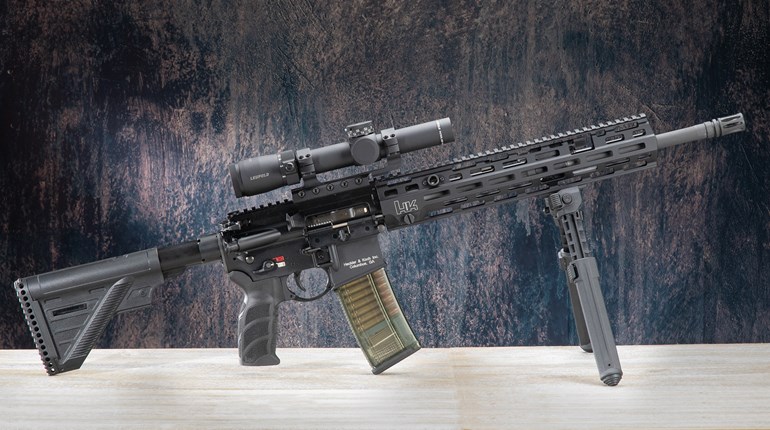
Robinson Armament may not be well known outside of the tactical-rifle cognoscenti, but the North Salt Lake City, UT, firm is hardly a newcomer to arms making. Founded in 1994 and still helmed by Alex Robinson—who studied, collected and built firearms starting in his teens—the company first imported Russian VEPR rifles, then made its first firearm, the M96 Expeditionary Rifle, in 1999. Pat-terned somewhat after the Stoner 63, which saw limited use by Navy SEALs and Marines in Vietnam, the M96 had unusual features, like the ability to be changed from a layout with the magazine inserted from the bottom, to one with the mag inserted from the top. There was also a belt-fed conversion kit designed for it, but never sold. Unhappily, this interesting rifle was expensive to produce due to multiple welds of steel stampings, and it was discontinued after a 6-year run.
The XCR-L reviewed here was designed in 2004 with the intent to win the U.S. Military’s Special Operations Forces Combat Assault Rifle (SCAR) competition that was eventually awarded to FN with its presciently named SCAR platform. Nevertheless, the Robinson Armament XCR garnered interest among enthusiasts and was first sold commercially in 2006. It was considered by many to be ahead of its time, and two decades and several improvements later, it still offers standout features rarely seen together on the same tactical rifle.
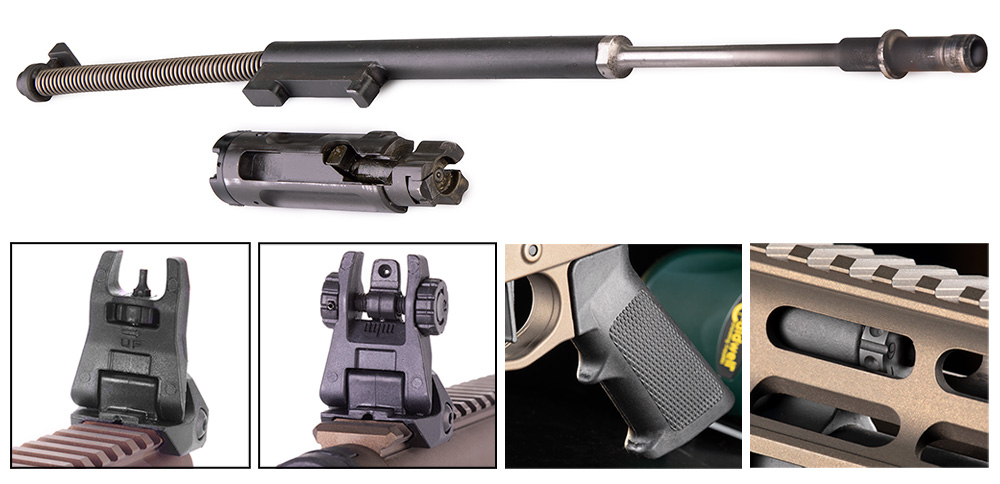
The XCR is gas-piston operated and constructed using two receivers joined by a captive pivot pin at the front and a takedown latch at the rear. The serialized lower re- ceiver houses the fire-control parts and is made from a 7075-T6 aluminum forging. The upper receiver is made from a proprietary grade of aluminum with strength and hardness between 6061 and 7075-T6 and contains the bolt-carrier group, operating rod, left-side charging handle and captive recoil spring. It is monolithic, meaning the handguard is integral with the upper receiver, not a separate part as with most AR-15s.
An adjustable, long-stroke gas system operates the rifle. The long-stroke is so named because the gas piston is attached to the operating rod and moves rearward more than the length of the cartridge when cycled. Short-stroke designs, in contrast, use a piston that isn’t connected to the operating rod, but moves it rearward by impacting it forcefully.
To regulate the gas flow activating the piston, an adjustable gas regulator is present. Its dial has eight numbered settings to optimize cycling reliability over a wide range of loads and provide repeatable settings—something most adjustable gas blocks and bolt-carrier gas keys used on some AR-15s do not. Setting “0” places the rifle into manual operation, which is ideal if you’re operating the XCR with a suppressor and require maximum stealth.
The action uses a rotating bolt that locks into the barrel extension and is reminiscent of the AK-47’s, but has three locking lugs instead of two, and the ejector is mounted to the upper receiver with two screws. The barrel is made from button-rifled 4150 CMV steel, chrome lined to mil-spec standards. Steel parts—except the stainless steel piston—are Parkerized, while aluminum parts are hardcoat anodized and finished with H-Series Cerakote.
Offered in two categories, the XCR provides shooters with several options. The XCR-L platform uses AR-15 magazines, and the XCR-M is for chamberings that require larger SR-25-pattern magazines. The L and M versions are available in several rifle, pistol and “Other Firearm” configurations, each with its own set of customizations like a choice of barrel, handguard, muzzle device, stock or arm brace and finish. “Other Fire- arm” is an ATF classification for a firearm that doesn’t fit into any existing definition. The XCR “Other” has options with barrel lengths from 9.5 to 12 inches, an adjustable arm brace, a vertical forward grip and an overall length greater than 26 inches. “Other Fire- arms” aren’t subject to NFA registration, but can’t be sold by an FFL to persons younger than 21.
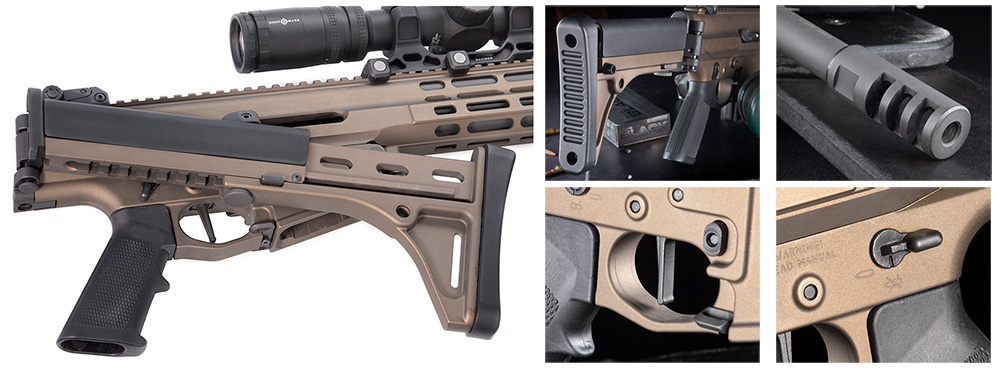
The XCR is unusually modular, allowing chambering and stock changes in less than 5 minutes using only two Allen wrenches: one to remove the barrel and another to remove the buttstock. Some changes also require a different bolt and magazine, but none require special tools, a vise or appreciable skill to accomplish. Moreover, replacing a worn barrel on an XCR is far easier than on an AR-15.
Hornady’s 6 mm ARC is among the most powerful cartridges that fit into an AR-15 magazine. It is based on the 6.5 Grendel and was designed for special military units as a caliber that would bridge the performance gap between the 5.56 NATO and 7.62 NATO cartridges while utilizing the M4’s lower receiver. It shoots flat, has minimal recoil and stays supersonic beyond 800 yards depending on load and barrel length. These ballistics dictate a rifle that is configured for intermediate-range shooting, so I selected the Competition variant XCR-L equipped with the longest, heaviest barrel offered. This variant is distinguished by its extended handguard that allows a bipod to be conveniently mounted closer to the muzzle for better stability, while the 18-inch barrel is relatively stiff.
For the best accuracy, Robinson suggested the three-chamber muzzle brake with symmetrical ports pointing left and right and the FAST 3 stock because it accommodates the widest range of scope heights and firing positions from prone to bench rest. My test rifle weighs 9 pounds, 4 ounces unloaded, measures 30.5 inches long with the stock folded and 38.5 to 42.75 inches with the stock open. Two steel magazines are included, a five-round and a 25-round version. They are of standard AR-15 design, except they use a 6.5 Grendel follower.
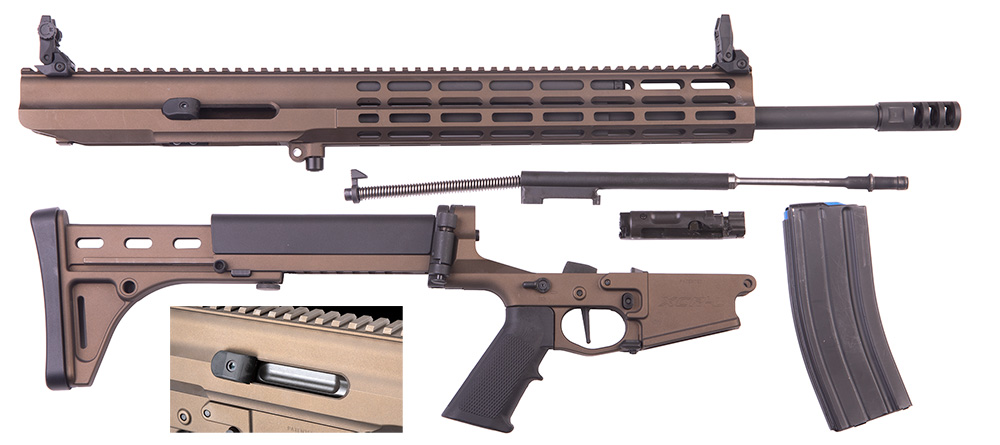
Though the XCR can be purchased with a rail adapter to accommodate various buttstocks, the FAST 3 stock has much to offer. Made from aluminum with a steel hinge, it locks into place open or closed without any wobble and has a check piece that can be adjusted to three comb heights by prying it off at the front, then reattaching at the desired height to precisely align your eye with an optic. If these settings aren’t adequate, the stock can be moved up or down at the hinge by removing two screws and resetting the hinge. Length-of-pull can be adjusted via a thumbwheel screw over eight settings from 12.25 to 16.5 inches and can be locked in place. The cheek rest and buttplate are plastic, and sling mounts include a slit and QD mount on either side. The stock folds and locks rightward and below the ejection port to allow fire-when-folded capability. If the hinge becomes wobbly, it can be adjusted for stability. When folded, a small rubber bumper prevents it from marring the receiver. Finally, the stock has a QD socket for a sling mount on the bottom.
XCR rifles come with an AR-15 A2-style grip and a polymer, flip-up, fully adjustable aperture rear and a protected-post front sight. All are replaceable with standard aftermarket parts should the user desire.
 Fieldstripping the XCR is quick and intuitive. With a verified unloaded rifle, press the takedown latch on the left rear of the upper receiver forward, then pivot the lower receiver downward. Remove the recoil spring, then pull the charging handle rearward to expel the operating rod and bolt carrier. The bolt slides out of the carrier and, by removing a single pin, the firing pin can be withdrawn from the bolt. The gas tube is then easily withdrawn from the front of the upper receiver.
Fieldstripping the XCR is quick and intuitive. With a verified unloaded rifle, press the takedown latch on the left rear of the upper receiver forward, then pivot the lower receiver downward. Remove the recoil spring, then pull the charging handle rearward to expel the operating rod and bolt carrier. The bolt slides out of the carrier and, by removing a single pin, the firing pin can be withdrawn from the bolt. The gas tube is then easily withdrawn from the front of the upper receiver.
Good workmanship was evident on my test sample by an even Cerakote finish, no visible machine-tool marks and tightly fitted parts. Minor flashing edges from the forging process remain on the lower receiver but are of no consequence, except perhaps to firearm obsessives. The left-rear side of the upper receiver is slightly higher than the lower by design to allow the charging handle to clear.
I tested the XCR for precision and ammo preference using the five-round magazine. The average five-shot groups of all three tested loads ranged from 1 to 1.18 inches measured at the shot centers. The largest groups ranged from 1.55 to 1.74 inches and were possibly caused by bullet tips that sometimes impacted the breechface during feeding and deformed. Robinson Armament is examining this, and potential solutions include a radiused feed ramp if this issue isn’t unique to our sample rifle.
Nonetheless, these results underscore an accurate rifle and a smooth, predictable two-stage trigger that broke crisply with no overtravel. Its 3-pound, 9-ounce pull weight is a bit heavy for a long-range precision rifle, but the XCR-L is designed to be a short-to-medium-range, tactical semi-automatic. The first stage weighed 2 pounds, 4 ounces, which allows the shooter to pause the trigger press to make final sighting corrections. Moreover, because the trigger face is flat and the trigger guard extends downward to accommodate winter-weight gloves, the shooter can position his or her finger at the trigger’s bottom for better leverage and a lighter 2-pound, 11-ounce pull.
After I optimized the gas regulator setting for the load, reliability was perfect during the 150-round test, except for a single failure to feed. And for those who reload the 6 mm ARC, ejected brass wasn’t dented thanks to a specifically designed gas valve, ejector angle and rubber brass deflector. The firing pin on my sample XCR pierced several primers on the Hornady loads, but a replacement firing pin corrected this.
Controls are ergonomic for right- and left-hand shooters. The safety levers have a 60-degree throw, al- lowing rapid manipulation and, like the magazine-release buttons, are mounted on both sides of the lower receiver in the same locations as an AR-15. The ambidextrous bolt catch/release is situated just ahead of the trigger guard and is easily activated by the trigger finger. After the last round is fired, it moves upward, locking the bolt rearward; pressing it down allows the bolt to spring forward. The round, non-reciprocating left-side charging handle is operable by left-handed shooters who wish to retain their firing grip by reaching under the receiver and swiping the handle rearward, knife-hand style the same way a right-handed shooter charges an AK-47. The charging handle also does double duty as a forward assist to remedy any minor out-of-battery stoppages, should they occur.
Ultimately, the XCR is feature-rich with very good ergonomics, accurate with the loads tested and offers better modularity and easier barrel changes than most of its peers. It also has one of the best non-custom triggers in its class and all the advantages of an adjustable gas system.






